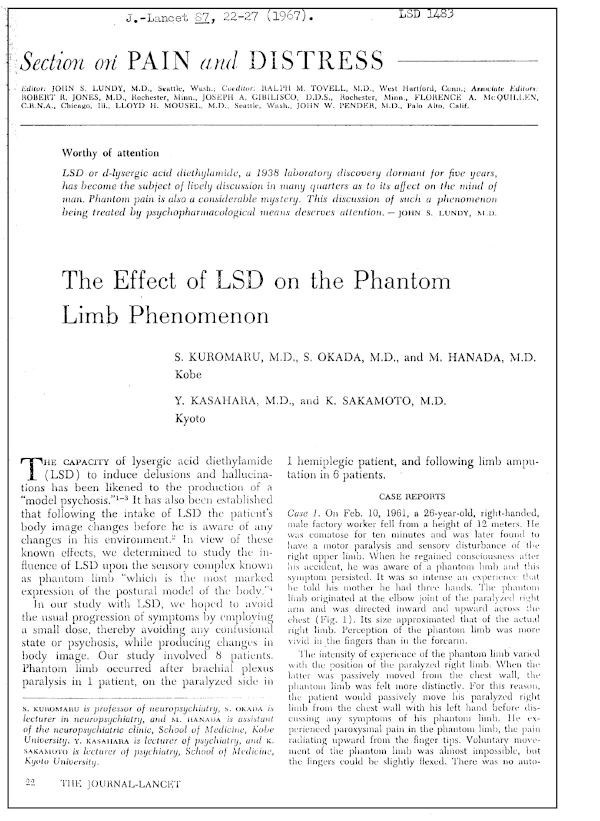Yesterday was Magic Mushroom Day, the nation’s unofficial celebration of the therapeutic benefits of psilocybin. If you weren’t aware, don’t feel bad; the holiday only came into being seven years ago, when an activist named Nicholas Reville launched the event as part of a broader campaign to educate Americans about the medicinal potential of psychedelic drugs.

Or perhaps we should say re-educate. Before the hippie counterculture of the 1960s gave them a bad name, psilocybin (the active ingredient in hallucinogenic mushrooms) and LSD were widely viewed as possible solutions to an array of physical and mental health problems. In fact, in 1967 — the famous Summer of Love, when the Beatles released Sgt. Pepper and Jefferson Airplane put out “White Rabbit”—one of the world’s leading medical journals published a clinical study of LSD’s ability to blunt phantom limb pain. Written by a quintet of Japanese doctors, the paper appeared in The Lancet, the UK’s answer to the New England Journal of Medicine. This 200-year-old publication embodies the authoritative voice of accepted medical wisdom. It’s as respectable as they come.
Before we continue, we should invoke the same caveats we issued when we wrote about this subject last year. Amplitude is not advising you to score some acid and start tripping to get rid of your PLP. We’re not even suggesting that there’s a scientifically proven link between LSD and PLP relief. Our only purpose here—in the spirit of Magic Mushroom Day—is to raise awareness about the medical profession’s inquiries regarding clinical application of psychedelic medicines.
And today’s message is simple: The theory that psychedelics might alleviate suffering from PLP isn’t new. It’s decades old. In fact, it’s nearly as old as LSD itself, which wasn’t synthesized until just before World War II. In 1962, less than 20 years after LSD’s hallucinogenic properties became known, the Japanese Society of Psychology and Neurology published a study titled “The Problem of Body Scheme and the Therapeutic Use of LSD25 on Phantom Pain.” In other words, PLP was present in the earliest wave of medical research regarding LSD.
The same five Japanese doctors who conducted the 1962 study authored the 1967 Lancet article, which was titled “The Effect of LSD on the Phantom Limb Phenomenon.” Cutting to the chase, the paper concluded: “In a dose of 50 micrograms, LSD benefited 7 out of 8 patients with phantom limb sensation and 5 out of 6 patients with phantom limb pain.” Accordingly, “LSD should be regarded as a useful drug in the treatment of phantom limb phenomena.”
The authors characterized PLP as “the most marked expression of the postural model of the body,” an early-20th-century concept which holds that our brains are constantly building 3-D models of our bodies and locating them within corresponding 3-D models of the environment. It’s considered a whole-brain exercise that, while heavily dependent on sight and touch, integrates inputs from multiple neurological centers. Since LSD radically alters modes of spatial perception and self-awareness, the authors hypothesized that it might jolt the brain out of dysfunctional patterns of model-building.
That theory was borne out to some degree in their research. All but one of the study subjects reported marked changes in phantom limb perception, and their experiences followed a similar pattern: They first perceived the phantom limb to be elongated. Within a couple of hours after receiving their dose, the residual limb began to feel lighter, and phantom pain was replaced by itching. By hour 3 phantom limb pain was markedly reduced, and the phantom limb itself was perceived to be shorter. Eventually, the subjects reported a complete absence of phantom limb sensation — their brains’ 3-D models of their bodies corresponded to reality. “[We postulate] that LSD achieved these effects by changing the patient’s body image and so destroying the psychological framework which was the genesis of the phantom limb sensation,” the authors concluded.
That same premise lies at the heart of current research into psychedelic PLP cures, which (as we’ve noted before) has recently emerged from a half-century of hibernation. Our November issue will include a feature article about the medical community’s renewed focus on the clinical potential of psilocybin, MDMA, and other consciousness-altering drugs. In addition to exploring whether such drugs can alleviate PLP, investigators are looking into possible therapies for other health challenges related to limb loss, including chronic depression and PTSD.
Look for that article in about six weeks. Until then, please accept our belated wishes for a happy Magic Mushroom Day.